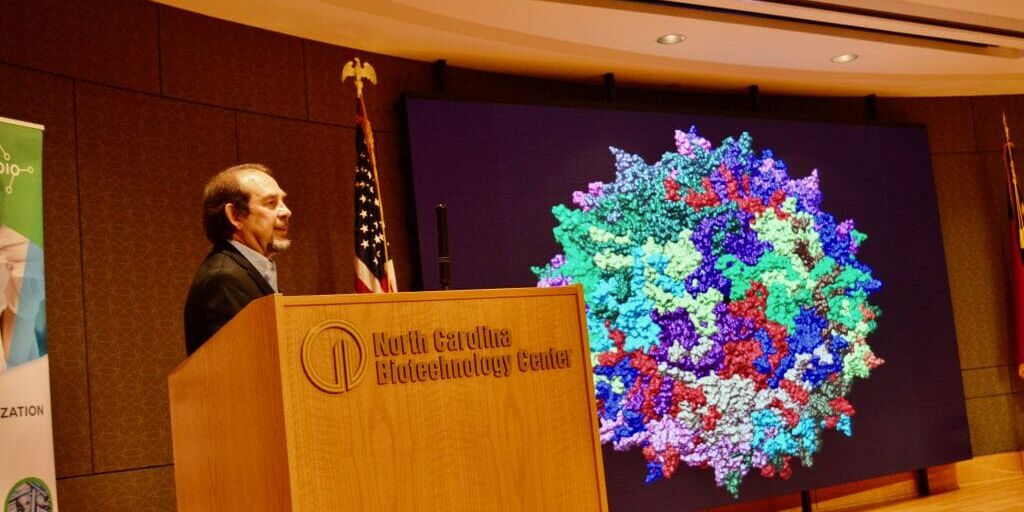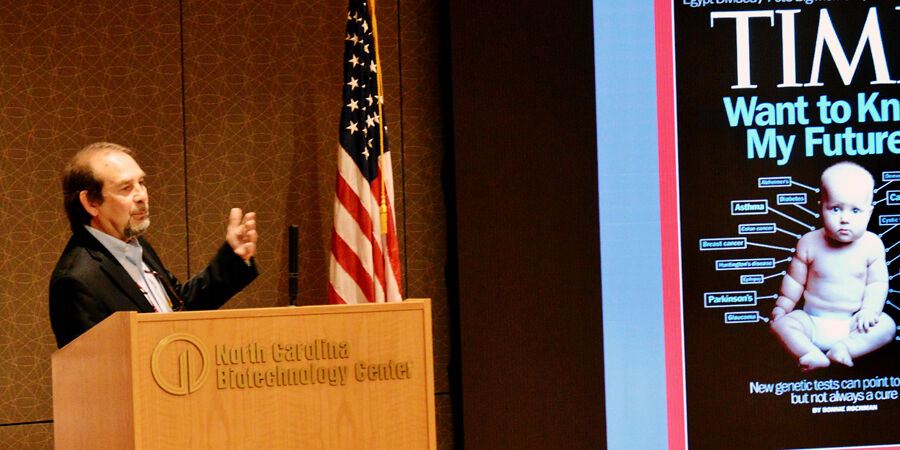Gene therapy pioneer Jude Samulski delivers powerful keynote at NCBIO 2021 Annual Meeting
Jude Samulski, Ph.D., told NCBIO Annual Meeting attendees that the field of gene therapy is the beginning of something that will transform lives forever. Therapies created today for rare diseases will tomorrow generate treatments for common ills like high cholesterol, diabetes and heart failure, he said.
Samulski is president and chief scientific officer of AskBio, a company he co-founded in 2001 to develop advanced gene therapies to erase genetic disease, especially in children. He delivered the keynote address at the 2021 NCBIO Annual Meeting Oct. 5 at the NC Biotechnology Center, giving a retrospective on his career and the development of gene therapy.
“When the human genome got sequenced, the 3 billion nucleotides that represent each and every one of us was finally identified,” he said. “What this represented was the cookbook for hair color, size of our shoes and everything else that enables us to be individuals.”
The process that makes copies of those 3 billion nucleotides is subject to error, those errors are mutations and those mutations can cause disease. In the U.S., about 1 in 10 people have a rare disease, and about 80% of those diseases have a genetic origin. Approximately 7,000 rare diseases have been identified, and about half of those afflicted are children, Samulski said.
"Each and every one of us carries about three to five lethal mutations that are varied in this encyclopedia of information, which is pretty amazing,” he said. “And then it's just a numbers game what is passed on and who gets what.
“Going forward, gene therapy is very simple – just put the information back, correct the disease, very simple concept.”

Sabin on Sunday
Samulski began his story during the polio epidemic of the 1950s.
“I’m a byproduct of Sabin on Sundays,” he said. “Most of you probably know the story of Jonas Salk, who came up with the first vaccine. It was a heat-killed vaccine. Sabin came up with another vaccine called the attenuated vaccine. And so, Sabin on Sunday was you got in line and got a sugar cube, but they put a drop of the polio vaccine on it, and you swallowed it.”
Samulski was born in 1954, when researchers had begun a major effort to uncover viruses that caused issues for humans, he said. By 1965, scientists had identified adeno-associated virus, a nonpathogenic virus that was discovered as the constant companion of a virus extracted from the adenoids. In 1971, research spurred on by the National Cancer Act ended up developing most of the reagents used today to deliver gene therapy.
“This is where I entered the picture as history continued to march,” he said. “I was going to graduate school at the University of Florida [in 1978]. My job was to take the genome out of AAV and clone it into bacteria so that we could grow it and characterize it, and we accomplished this in 1982.”
Their goal at UF was to conquer and take apart AAV so that they could become masters of how to make the virus, he said. By cloning AAV, they were able to reproduce everything needed to create an AAV particle, and then they could insert a piece of foreign DNA in place of the virus’s own genome.
Samulski moved on to a postdoctoral position at Princeton University where he said they developed the viral vectors of today by removing the genes of AAV, putting in foreign DNA and then shuttling the virus back to the target cells. They learned to add firefly DNA to the virus, which allowed it to be visually tracked in cells.
These advances led to a faculty position for Samulski at the University of Pittsburgh where he began to direct AAV to specific targets in large animals. This led to his first efforts to treat a disease – muscular dystrophy – using AAV to deliver a genetic therapy.

Building in the Research Triangle
In 1993, Samulski accepted a faculty position at the University of North Carolina at Chapel Hill thanks in part to a significant grant from the NC Biotechnology Center. In Chapel Hill, he founded the UNC Gene Therapy Center.
“We kept getting better and making our vectors that were going into patients and animals and being delivered and getting published all over the place,” Samulski said.
“Everyone in the country was coming to North Carolina to get their vector,” he said. “Regardless of what institution you're at, you're writing to us, ‘Can you make this, can you make that?’ Not only were we making vector for the majority of the U.S., we were making vector for essentially the world.”
During this time, Samulski’s team developed a treatment for a genetic form of blindness that has since been approved by the FDA, making it the first gene therapy drug to be approved in the U.S., he said. His operation expanded as he built relationships with local companies in Research Triangle Park and continued to set the standard for viral vector production.
“We had a footprint that allowed us to make clinical grade material that the FDA would approve, and we were building a staff that was growing leaps and bounds over most traditional academic settings,” he said.
Samulski’s success in building relationships between the university, Triangle biotechs and the state legislature began to increase his visibility to foundations and organizations interested in rare disease, as well as drawing the attention of the parents of children afflicted with those conditions. Samulski remembered a boy with Duchenne muscular dystrophy, a girl with giant axonal neuropathy and two little girls with Friedreich ataxia. The attention was becoming overwhelming, he said.
“I was fortunate enough to go to a class at the [UNC] Business School, where Sheila Mikhail was giving a lecture in life sciences about patents,” Samulski said. “I went up to her afterwards and offered her some cheese balls. And at the same time, she was starting to say, ‘What do you do?’ and I explained it to her.
“She said, ‘Oh, we can make this work.”
Mikhail and Samulski created Asklepios Biopharmaceutical – shortened to AskBio these days – in 2001 and created separate incubator companies under the AskBio umbrella for each platform or therapy. The first of these companies was Chatham Therapeutics, which developed a treatment for spinal muscular atrophy.

A parent’s gift to others
After AskBio was up and running, a father of some means came to North Carolina to talk to Samulski about the man’s son, who had Duchenne muscular dystrophy.
“He said he didn't want anyone else to go through what he went through trying to find a cure for his kid,” Samulski said. “He said that [his son] drank mud shakes from Mexico, had crystals waved over his head in India, essentially tried everything, magic. [The father] knew we were not going to help his kid.
“He wrote a check for $3 million; he got on his plane and flew home. And basically, Sheila took that money and started Bamboo [Therapeutics], and Bamboo was focused primarily on treating muscular dystrophy.”
Bamboo Therapeutics began a 10-year effort to develop a treatment for Duchenne muscular dystrophy. When it was ready, they began clinical trials at Duke University.
Samulski clicked to the next slide in his presentation, one showing a small boy with Duchenne struggling to climb stairs, stepping up with his stronger leg and dragging the other behind him. He had to climb four steps to be admitted to the trial.
“This is the first patient ever to be treated,” Samulski said. “He is like the Gemini astronauts; I mean they all have the right stuff. [The boy] was about three months from going into a wheelchair, so his parents were very brave and bold to take this step.
“Now realize, through a port, we put in 10 trillion billion viruses [into the boy], not really knowing what would happen in a human.”
Samulski’s next video shows the boy one month after his therapy practically bounding up the stairs by comparison, each leg doing its part to propel him upward.
“It is truly transformational and spearheaded by a parent who had no chance of helping his own kid,” Samulski said, his voice breaking with emotion.
Bamboo partnered with Pfizer in order to scale up production and advance the Bamboo treatment, which is currently in Phase III clinical trials.
A $4 billion offer
AskBio was attracting attention, and Bayer came in with an offer to buy the company for $4 billion.
“It wasn’t about the money anymore; it was looking for someone who also understood the vision,” Samulski said. “It was looking for someone who could take what we were doing and make it more effective.”
In 2021, AskBio was acquired by Bayer but operates in RTP independently from the parent company. The company currently has clinical trials underway for Pompe disease, Parkinson’s disease and congestive heart failure.
